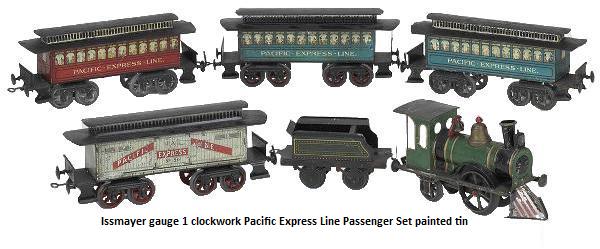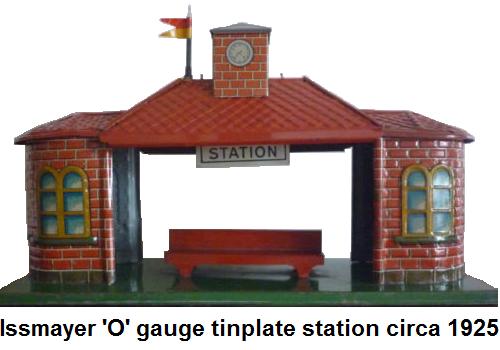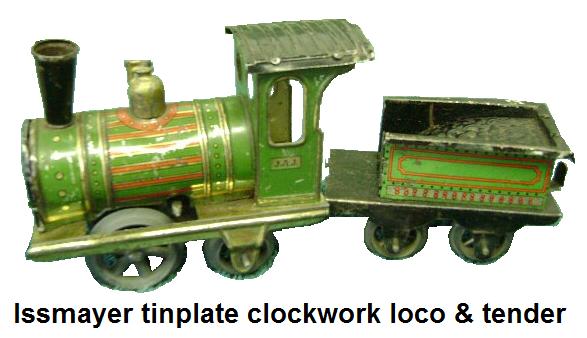 Johann Andreas Issmayer was born into a family of toymakers and started his own company in
1861 in Nürnberg, Germany. Issmayer manufactured toy trains, cars and other motorized vehicles from
1861 until 1932.
According to history, this firm had a well illustrated catalogue, but these have all disappeared and have not
been found since. Issmayer toys are therefore only known through retail catalogues and through various
collections. Before starting the production of trains in 1879, mainly steam engines were made.
Johann Andreas Issmayer was born into a family of toymakers and started his own company in
1861 in Nürnberg, Germany. Issmayer manufactured toy trains, cars and other motorized vehicles from
1861 until 1932.
According to history, this firm had a well illustrated catalogue, but these have all disappeared and have not
been found since. Issmayer toys are therefore only known through retail catalogues and through various
collections. Before starting the production of trains in 1879, mainly steam engines were made.
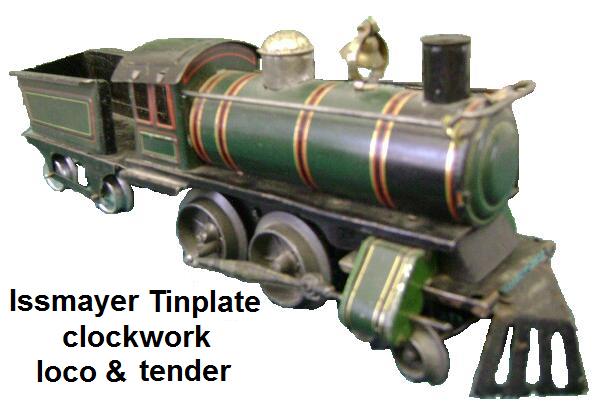 Like the other German manufacturers of the era - Bing &
Schöenner, Issmayer produced more elaborate and detailed models.
They mainly sold large, live-steam-powered locomotives to their home market, and cheap
colorful, clockwork versions were imported to the USA. The trains were primarily tinplate,
with lithography. There were three main methods of printing designs onto tinplate used;
directly from a lithographic stone, transfer printing with paper, and offset lithography
using a rubber roller. Issmayer lithography is very bright and shiny with lacquered gold lining. The
lithography methods were a less expensive process than hand painting, and looked better.
The first trains were 30mm gauge, which was not quite a true 'O' gauge. Eventually gauge 1
models were added.
Like the other German manufacturers of the era - Bing &
Schöenner, Issmayer produced more elaborate and detailed models.
They mainly sold large, live-steam-powered locomotives to their home market, and cheap
colorful, clockwork versions were imported to the USA. The trains were primarily tinplate,
with lithography. There were three main methods of printing designs onto tinplate used;
directly from a lithographic stone, transfer printing with paper, and offset lithography
using a rubber roller. Issmayer lithography is very bright and shiny with lacquered gold lining. The
lithography methods were a less expensive process than hand painting, and looked better.
The first trains were 30mm gauge, which was not quite a true 'O' gauge. Eventually gauge 1
models were added.
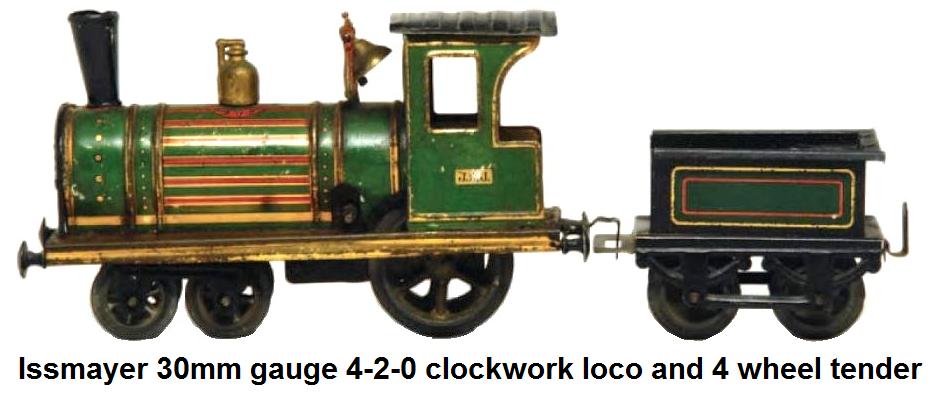 Johann Issmayer believed that trains with fine lithographic printing and
inexpensive clockwork mechanisms would be very marketable. Many of the trains that Issmayer made
were resold under other labels by other manufacturers of the era, including Bing and
Karl Bub. Schooled collectors of European toy trains who know
what to look for can tell the difference, but the average collector would not be able to do so.
A partnership with Bub and Carette allowed all three companies
to produce similar looking trains which often had only the logo that was different. Issmayer
also supplied parts, such as clockwork motors, to Carette, and Schöenner. Some Issmayer products
were actually made by Hess.
Johann Issmayer believed that trains with fine lithographic printing and
inexpensive clockwork mechanisms would be very marketable. Many of the trains that Issmayer made
were resold under other labels by other manufacturers of the era, including Bing and
Karl Bub. Schooled collectors of European toy trains who know
what to look for can tell the difference, but the average collector would not be able to do so.
A partnership with Bub and Carette allowed all three companies
to produce similar looking trains which often had only the logo that was different. Issmayer
also supplied parts, such as clockwork motors, to Carette, and Schöenner. Some Issmayer products
were actually made by Hess.
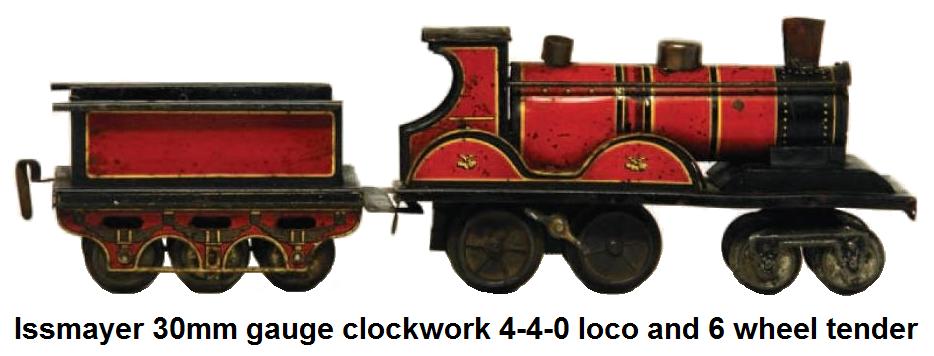 Issmayer utilized an assembly method that became
popularized at the time with all German
tinplate toy makers. German manufacturers had devised a new method for assembling tinplate toys
by means of tabs and slots. This sped up the manufacturing process considerably by eliminating
the need for hand soldering the pieces of the trains together.
Issmayer utilized an assembly method that became
popularized at the time with all German
tinplate toy makers. German manufacturers had devised a new method for assembling tinplate toys
by means of tabs and slots. This sped up the manufacturing process considerably by eliminating
the need for hand soldering the pieces of the trains together.
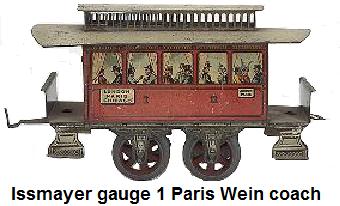 The company is also credited with pioneering the development of modern day track systems. Issmayer
designed sectional, 2 rail tinplated track, that utilized hollow, rolled-tin rails. These rails were
fastened to tin metal stamped ties and could be joined by pins fitted into the ends of the rails.
With just two types of short rail sections, the straight and the curved, a railway system of
any size could be constructed. This facilitated inclusion of track systems in the form of a
small loop, with each complete train set sold. Larger systems could be built or smaller systems
expanded, by acquiring additional sections of track.
The company is also credited with pioneering the development of modern day track systems. Issmayer
designed sectional, 2 rail tinplated track, that utilized hollow, rolled-tin rails. These rails were
fastened to tin metal stamped ties and could be joined by pins fitted into the ends of the rails.
With just two types of short rail sections, the straight and the curved, a railway system of
any size could be constructed. This facilitated inclusion of track systems in the form of a
small loop, with each complete train set sold. Larger systems could be built or smaller systems
expanded, by acquiring additional sections of track.
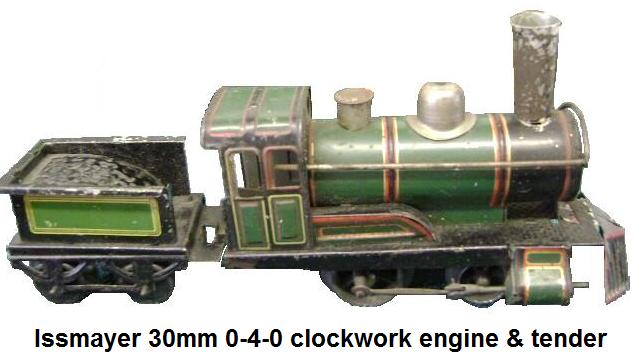 Johann Andreas Issmayer passed away at the age of 90 in 1922. Previously, his son-in-law,
J.G. Weissgerber, took over the company and continued as head until he died in 1926. Then
August Weissgerber, Issmayer's grandson took the reins. The company existed until 1932.
Johann Andreas Issmayer passed away at the age of 90 in 1922. Previously, his son-in-law,
J.G. Weissgerber, took over the company and continued as head until he died in 1926. Then
August Weissgerber, Issmayer's grandson took the reins. The company existed until 1932.
Issmayer trains are very appealing to collectors and are
among the most toylike and charming of antique toy trains.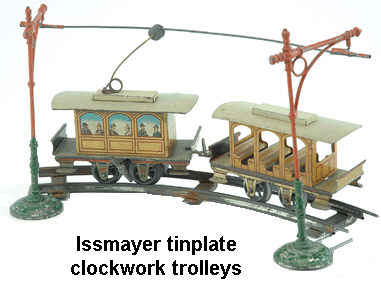 They are easily identified via the 'J.A.J. Made in Germany' trademark
typically located on the corner or bottom of the item. One of the rarest of all Issmayer trains is a tinplate model of
an armoured military clockwork set circa 1900. Only one example is known to exist and it sold at auction for a 4-figure price.
At a 2009 auction in Pennsylvania, a pair of finely lithographed Issmayer clockwork
tin trolleys offered with six correct cast-metal trolley-wire supports and a section of track drew
a winning bid of $9,200.
They are easily identified via the 'J.A.J. Made in Germany' trademark
typically located on the corner or bottom of the item. One of the rarest of all Issmayer trains is a tinplate model of
an armoured military clockwork set circa 1900. Only one example is known to exist and it sold at auction for a 4-figure price.
At a 2009 auction in Pennsylvania, a pair of finely lithographed Issmayer clockwork
tin trolleys offered with six correct cast-metal trolley-wire supports and a section of track drew
a winning bid of $9,200.
Also in 2009, an Issmayer 'O' gauge clockwork passenger train set with an 0-4-0 locomotive and two-axle tender,
hand-painted in lined green with pressed planking to the boiler and two-axle 1st/2nd passenger coaches
- one lithographed in red and gold, the other in a washed blue and silver, along with a circle of track, key,
rail gauge, instructions in original box with gold and lake label on black background with motif
'New Self-going Circular Railway' in English, French and German and an evocative
illustration inside the lid with children gathered around a table and playing trains, circa 1897, sold
at a Christie's Auction for £3,760 ($6,550).


